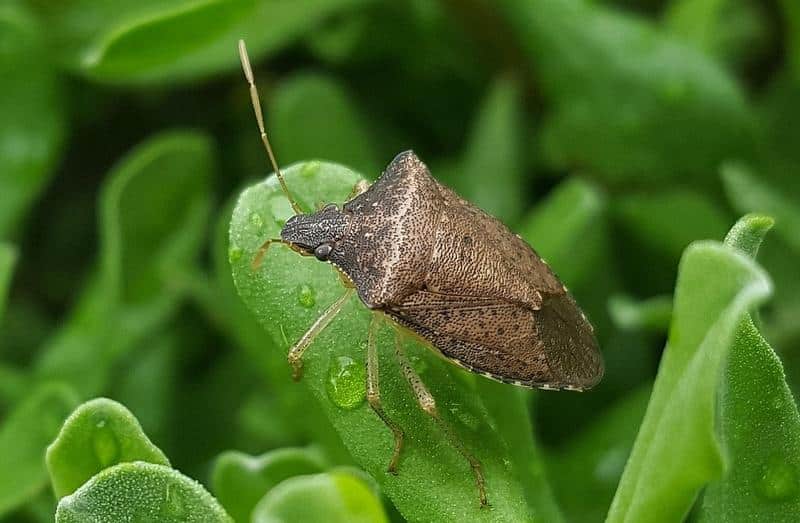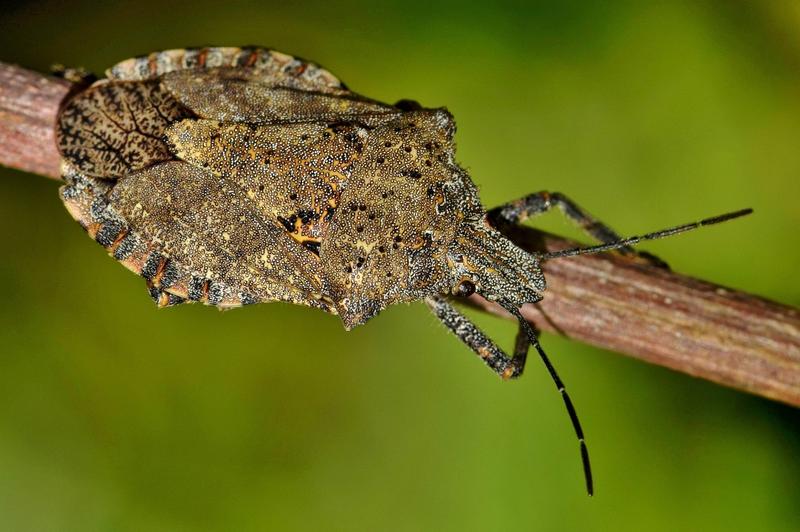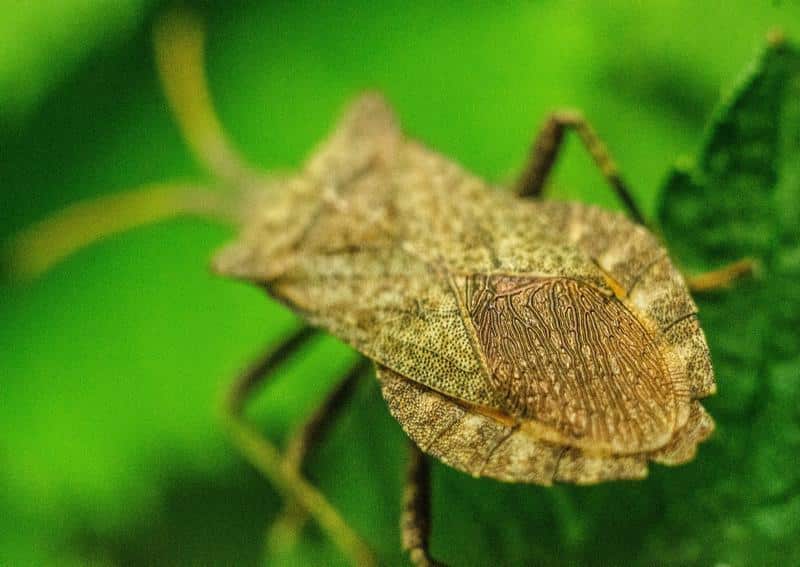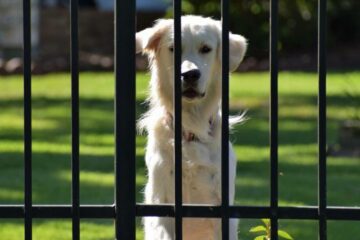Are Stink Bugs Poisonous to Dogs? Can Dogs Eat Stink Bugs?
Are stink bugs poisonous to dogs? Can dogs eat stink bugs? In this article, we’ll answer these and teach you the commands you should know to stop your dog eating stink bugs (more formally known as the brown marmorated stink bug), other issues you’ll need to address, the signs to look for, and what to do (if anything)!
Once we’ve covered those things, we’ll finish up by answering if stink bugs bite dogs, and by giving you all the instructions you’ll need to keep stink bugs away from your property. Soon, you and your dog won’t have to mess with these obnoxious bugs anymore. Keep reading!
Are Stink Bugs Poisonous to Dogs?

Stink bugs are not poisonous to dogs. However, if a dog eats a stink bug, it may cause mild to moderate discomfort due to the bug’s foul-tasting defensive chemicals. Severe reactions are rare but may occur, particularly if the dog ingests a large number of stink bugs.
Are Stink Bugs Toxic to Dogs?
Stink bugs are not toxic to dogs, but they do possess a unique defense mechanism that can indeed cause unpleasant reactions in dogs. This mechanism involves the release of a noxious-tasting chemical substance, intended to deter predators.
When a dog bites or eats a stink bug, it’s exposed to this foul-tasting chemical, often causing the dog to drool excessively, vomit, or show other signs of discomfort. Moreover, if this chemical comes into contact with a dog’s eyes, it can cause irritation and distress.
Dogs Eating Stink Bugs: Risks and Symptoms
When dogs eat stink bugs, they’re likely to experience mild to moderate discomfort. Symptoms can include excessive drooling, vomiting, or a noticeable reluctance to eat due to the unpleasant taste lingering in their mouth.
In the majority of cases, these symptoms are temporary and subside once the dog has had a chance to rid the taste from their system. However, if your dog appears to be in significant distress, the symptoms persist for an extended period, or if your dog has consumed a large number of stink bugs, you should contact your veterinarian right away.
Teaching the ‘Stay’ Command
To stop your dog from eating stink bugs, the ‘stay’ command can be helpful. Start by asking your dog to ‘sit’. Once seated, show them your open palm and say ‘stay’. Take a few steps back. If your dog stays put, give them a reward. Repeat the process, gradually increasing the distance and duration of the ‘stay’. Always reward them for complying to reinforce the behavior.
Training Your Dog to ‘Leave It’
Another effective command is ‘leave it’. Start with a treat in both hands. Open one hand and say ‘leave it’. Most dogs will go for the open hand, but close it immediately. Once your dog stops trying and pulls away, say ‘good dog’ and give them a treat from the other hand. Repeat this process, gradually moving towards using the command with real items.
These steps will get your dog to stop eating stink bugs, but it’s important to remember that the underlying behavioral issues (prey drive, curiosity, overexcitement, etc.) that were causing all of this to begin with will still be present. And until you address those, any positive changes you see are only going to be temporary.
“Well, how do I make these changes last?”
By getting your dog to truly choose to follow your direction, that’s how. I tried many times to write out how you can do that before deciding it made more sense to just link you to the free video series that explains it better than I’d ever be able to.
The series is by a man named Dan who is one of the world’s leading dog obedience trainers. In it, he teaches you how to put an end to things like your dog eating stink bugs and all other misbehavior using his fast and easy-to-follow methods.
In the first video, Dan will reveal to you why the two most common methods of dog training only doom you to failure. You can watch the video now by clicking here. Follow the proven system he’ll show you in his series and you’ll never have to spend another second worrying about your dog eating stink bugs ever again!
Can Dogs Eat Stink Bugs?

Dogs cannot eat stink bugs. While not generally considered poisonous, stink bugs can cause discomfort in dogs due to their foul-tasting defensive chemicals. It can lead to symptoms such as drooling, vomiting, and loss of appetite.
Dog Ate Stink Bug: What To Do?
If your dog has eaten a stink bug, the first thing you need to do is to keep an eye out for symptoms like excessive drooling, vomiting, or reluctance to eat. These signs usually indicate that your dog is trying to cope with the unpleasant taste left by the bug in their mouth.
Make sure your dog has access to plenty of fresh water to help rinse out the taste from their mouth. The symptoms should gradually decrease, but if symptoms persist, your dog appears distressed, or if they have consumed a very large number of bugs, it’s important to seek veterinary care immediately.
My Dog Ate a Dead Stink Bug
If your dog ate a dead stink bug it might raise additional concerns, but the reaction should be similar to eating a live one, as the unpleasant-tasting chemicals are present in the bug’s body even after death.
As with a live bug, monitor your dog closely for any of the aforementioned symptoms. Provide access to fresh water and observe whether the discomfort subsides over a short period. In the case of prolonged discomfort or severe symptoms, do not hesitate to contact a vet immediately.
Dogs Eating Stink Bugs: How to Stop
The key to preventing your dog from eating stink bugs is to utilize basic obedience commands like “leave it” or “stay”. These commands can interrupt your dog before they have a chance to snap up the bug. We explain how to do both in the first section.
In addition to training, you can use deterrents such as bitter sprays on areas where stink bugs commonly appear to discourage your dog from sniffing around. Finally, to minimize encounters with these bugs, try to keep your home free of stink bugs by sealing entry points and using stink bug traps.
In conclusion, although stink bugs are not technically poisonous to dogs, it’s best to prevent your pet from eating them due to the unpleasant reactions they can cause (learn how in the first section). If your dog does eat a stink bug, keep a close eye on them and talk with your veterinarian if necessary.
You’ll want to get a handle on this type of behavior from your dog now, as it will also make keeping them safe from other insects easier.
Once you’ve learned the necessary commands, you won’t have to worry about random things like if slugs are poisonous to dogs, if cicadas are poisonous to dogs, if house centipedes are poisonous to dogs, if tarantulas are poisonous to dogs, if salamanders are poisonous to dogs, if boxelder bugs are harmful to dogs, or even what will happen if your dog eats a moth, a Japanese beetle, or a millipede.
Stink Bugs and Dogs: Symptoms

If a dog interacts with or ingests a stink bug, the result can be symptoms like excessive drooling, vomiting, and loss of appetite. In some cases, dogs may also exhibit signs of discomfort, restlessness, and gagging. The noxious chemicals in stink bugs can irritate a dog’s gastrointestinal tract, leading to these adverse reactions.
- Excessive Drooling: A primary sign that your dog may have interacted with a stink bug is excessive drooling. This happens because the stink bug’s defensive chemicals are extremely bitter and unpleasant, triggering an increase in salivation as the dog’s body instinctively attempts to cleanse its mouth. Furthermore, if these chemicals reach the stomach, they can cause irritation to the gastrointestinal tract, potentially furthering the excessive drooling as the dog’s system tries to soothe the affected area.
- Vomiting: If your dog ingests a stink bug, it’s likely that vomiting will occur. The body naturally tries to expel harmful substances, and the stink bug, along with its foul-tasting chemicals, are no exception. The irritation caused by these chemicals in the dog’s gastrointestinal tract can further stimulate the vomiting reflex, making this a common symptom of stink bug ingestion.
- Loss of Appetite: A stink bug’s chemical defenses can cause temporary loss of appetite in dogs. The bitterness and unpleasant taste of the bug, combined with the potential stomach upset caused by the irritating chemicals, can make dogs reluctant to eat for a while after the encounter.
- Discomfort and Restlessness: A dog that has eaten or had oral contact with a stink bug may exhibit signs of discomfort such as pacing or restlessness. Also, it may frequently attempt to clean its mouth due to the residual taste of the bug. This discomfort can also extend to the gastrointestinal tract if the bug was ingested, causing general restlessness.
- Gagging: The stink bug’s chemicals can irritate a dog’s throat and gastrointestinal tract, leading to gagging or coughing. This is a reflexive attempt by the body to clear the irritant, whether from the throat or further down in the digestive tract.
Stink bugs and dogs interacting can result in symptoms such as excessive drooling, vomiting, loss of appetite, discomfort, restlessness, and gagging. These symptoms, primarily resulting from the irritation of the dog’s gastrointestinal tract by the stink bug’s chemicals, are generally transient and resolve without causing lasting harm. However, should symptoms persist or worsen, it’s important to talk with a veterinarian right away.
To keep your dog safe in the future, prevention is always the best option, and we explain how to do this in the first section.
Do Stink Bugs Bite Dogs?
Stink bugs do not bite dogs. They are not equipped with the necessary mouthparts to bite or sting. Instead, they use a stink gland to spray a foul-smelling, irritating chemical as a defense mechanism. However, if a dog eats a stink bug, this can lead to unpleasant symptoms due to the bug’s defensive chemicals.
- Stink Bug Anatomy: Unlike some other insects, stink bugs do not have biting or stinging mouthparts. Their mouthparts are designed for piercing and sucking, which they use to feed on plant juices. So, they do not bite dogs, people, or other animals.
- Stink Gland: The primary defense mechanism of a stink bug is not a bite or a sting but a foul-smelling spray produced by glands located on the underside of their body. When threatened, they release this pungent odor which deters predators. If this substance gets into a dog’s mouth or eyes, it can cause irritation.
- Indirect Harm to Dogs: While stink bugs can’t bite or sting dogs, they can still pose an indirect threat. If a curious dog decides to eat a stink bug, the bug’s defensive chemicals can cause gastrointestinal upset, leading to symptoms like excessive drooling, vomiting, and loss of appetite.
- Prevention is Key: Since the primary risk to dogs from stink bugs comes from ingestion, it’s important to prevent dogs from eating these insects. This might involve training your dog to avoid them, regularly checking your home for stink bugs, or even seeking professional pest control if stink bugs are common in your area.
- Veterinary Care: If your dog has ingested a stink bug and is showing signs of distress, it’s important to seek veterinary care. While the effects are usually not serious, a vet can provide appropriate care and advice for any discomfort your dog may be experiencing.
In conclusion, stink bugs do not bite dogs. Their defense mechanism involves spraying a foul-smelling substance, which can cause irritation if it comes into contact with a dog’s mouth or eyes. The main risk to dogs is from eating a stink bug, which can lead to unpleasant symptoms. If your dog is showing signs of distress after encountering a stink bug, it’s a good idea to consult with a vet.
To prevent any future negative interactions, go back to the first section now and we’ll explain the commands you’ll need to know.
How to Keep Stink Bugs Away
Keeping stink bugs away from your property involves proactive measures, including sealing entry points in your home, maintaining your garden, and using natural or chemical repellents. Regular inspections and cleanups can also help in managing a stink bug population.
Seal Entry Points to Keep Stink Bugs Out
Stink bugs, like many pests, can find their way into homes through even the smallest cracks and openings. Thoroughly inspect your property for any potential entry points, such as gaps around windows and doors, crevices in siding, or utility openings.
These should be promptly sealed with high-quality silicone or silicone-latex caulk. Don’t forget to check less obvious places, such as where utility pipes enter the house, as these can also be popular access points for stink bugs.
Maintain Your Garden to Deter Stink Bugs
Proper garden maintenance plays a crucial role in deterring stink bugs. Avoid practices that can attract stink bugs, such as overwatering or over-fertilizing your plants. Regularly remove any dead plants, fallen fruits, and weeds from your garden. These can serve as hiding spots or food sources for stink bugs, so keeping your garden clean can help prevent an infestation.
Use Natural Repellents to Ward Off Stink Bugs
Certain natural repellents can effectively keep stink bugs at bay. Essential oils, such as mint or neem, can serve as deterrents. Dilute these oils in water and spray them around potential entry points or in areas where you have noticed stink bug activity. Be mindful to use these sparingly, as some pets or people may be sensitive to strong scents.
Use Chemical Repellents for Stink Bug Control
If natural remedies aren’t cutting it, pesticides designed for stink bugs can be used as a last resort. Be sure to follow the product’s instructions carefully, and avoid spraying in areas that children or pets frequently access. Always use such products responsibly, as misuse can potentially harm non-target organisms and the environment.
Conduct Regular Inspections and Cleanups to Prevent Stink Bug Infestation
Frequent inspection of your property and prompt cleanup of any spotted stink bugs can prevent a minor problem from becoming a major infestation. Pay attention to the areas where stink bugs are commonly found, such as in garden areas or near windows and doors. If the infestation becomes too large to manage, consider seeking help from professional pest control services.
In conclusion, keeping stink bugs away requires a multi-pronged approach involving home maintenance, garden care, the use of repellents, and regular cleanups. It’s always best to take preventative measures before a full-blown infestation occurs.
I’m sure you’re ready to quit worrying about these smelly insects, so I’ll let you get started on all of this now. Good luck, and thanks for reading our article “Are Stink Bugs Poisonous to Dogs? Can Dogs Eat Stink Bugs?”





